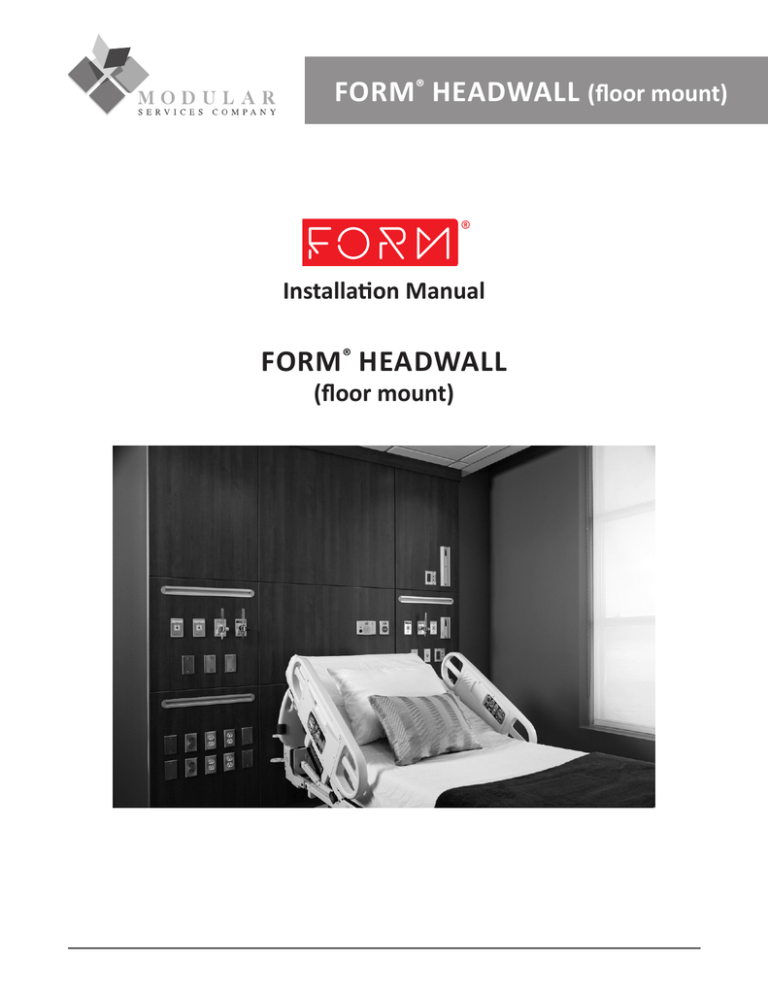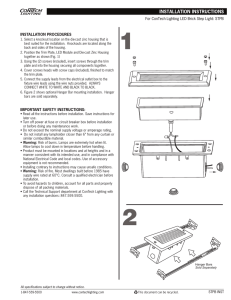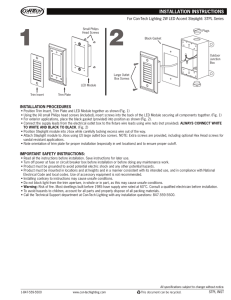Form Headwall (floor mount)
advertisement

FORM® HEADWALL (floor mount) Installation Manual FORM® HEADWALL (floor mount) OVERVIEW The Form® is a UL-listed configurable headwall system. This system includes multiple horizontal equipment channels integrated into the fascia of the unit which provide mounting points for a variety of accessories. Included in the system are medical gas and electrical services, as well as provisions for nurse call systems, communications, and future additional services. This document gives installation instructions specific to units that are surface-mounted (mounted on the face of an existing partition), as well as being mounted to the floor. The illustrations shown in this document are examples which will be similar to but not exactly like all headwalls in this category. Installation instructions for floating units (hanging from the surface of the wall but not touching the floor) are provided in a separate document. UNPACKING AND INSPECTION 1. Upon receipt of units and prior to unpacking, inspect shipping containers for damage. Document any damage found and notify the carrier and Modular Services Company. 2. Locate the carton for the unit you wish to install. Labels at each end of the carton identify the unit type and general description of contents, as well as the room number or area of installation (if applicable). 3. Unpack the unit from shipping container, taking care not to damage the unit. 4. Verify that all components are included, according to the packing slip. 5. Inspect the units for defects in materials or workmanship prior to installation. It is the responsibility of the customer to report any damage or deficiencies to Modular Services Company immediately upon discovery. PREPARATION Review the final approved shop drawings and the submittal booklet, which will provide you with technical details specific to your installation, such as: • Equipment types and quantities • Room numbers and location in the building (if applicable) • Electrical requirements • Structural blocking requirements Figure 1. Structural Blocking • Rough-in template locations (for back-fed units only) STRUCTURAL BLOCKING Structural blocking must be provided in areas shown in Figure 1 for proper headwall anchorage. Blocking typically consists of 2"x6" wood framing members or steel channel, minimum 16 ga. thickness. The width of the blocking must be greater than the width of the headwall to allow for varying site conditions while continuing to provide structural support to the far outside edges of the unit. Modular Services recommends extending the blocking to at least the next stud beyond the edge of the unit. Exact location of blocking is dependent on job-specific model of headwall being used and can be found on job-specific drawings. 2 TEMPLATE INSTALLATION For back-fed headwalls, the rough-in service plates must be installed on the stud wall before the interior finish. These assemblies ship in two pieces and are butted together at the center line of the headwall (Figure 2). The arrows that are cut into the plates point to the vertical center line for easy verification of proper orientation. The height of the horizontal centerline of the junction boxes is noted on the shop drawings included with the rough-in service assemblies. These assemblies must be installed within 0.25" of the center lines to ensure proper fit and function of the finished headwall. NOTE: This step is not relevant to units having junction boxes located above the finished ceiling. Figure 2. A Center line of headwall DETAIL A Rough-In service plates butt together on the center line of the headwall along the edges with arrows. Horizontal center line; dimension can be different. Refer to job-specific details included with shipment. UNIT INSTALLATION 1. Install the base of the headwall by first positioning the back side against the interior finish, then positioning it in the correct horizontal location. Anchor the base to the floor where there is contact between the two. Do not place an anchor where there is a valley in the floor and attempt to force the base to contact the floor in that location (Figure 3). Then, place a level on the top surface of the base and raise or lower one end of the base until the top surface is level. Use #8 low-profile head, self-drilling screws (provided) to secure the top portion of the base to the bottom, thereby locking the top surface in a level position. Figure 3. Insert floor anchors in at least two slots but only where contact exists between base and floor. (Do not try to close gap between base and floor by installing anchor at a location where a gap exists.) Front side Back side (abutts wall surface) #8 low-profile head, self-drilling screws in these locations when top surface is level 3 2. Place left section onto base and secure it to the base with one #8 low-profile head screw, provided (Figure 4). Secure the top of the headwall with one #12 fastener (by others) through the top anchor plate into the structural blocking, as close to the outside edge of the headwall as possible. Further secure the top of the wall section using #12 fasteners into partition wall studs where possible. Figure 4. Top anchor plate (use #12 fasteners to secure to wall studs) Secure left side of wall section to base B #8 low-profile head screw DETAIL B DETAIL C C 3. Install the next wall section by engaging the tabs on one stud into the slots of the adjoining stud and then moving the wall section down to lock the studs together (Figure 5). Install two #8 low-profile head screws (provided) at the wall section joint and #12 fasteners (by others) at top anchor plate into wall studs where possible. Figure 5. DETAIL D D Engage tab of one stud into slot of adjoining stud and slide wall section down to lock sections together 4 4. Repeat the process above to install sections 3 and 4, making sure to secure the right section of the headwall to the structural blocking as close to the outside edge as possible. (Figure 6). Figure 6. MEDICAL GAS CONNECTIONS Medical gas outlets are pre-manifolded and terminated near the top of each section, or as indicated on the approved drawings. 1. Use extreme care in making medical gas service connections. 2. Each single-point connection has been provided with a color-coded medical gas label. 3. All medical gas connections are to be made and tested in accord with NFPA 99. ELECTRICAL CONNECTIONS 1. Make sure all electrical power circuits are locked off prior to hook up. 2. Review wiring diagram or shop drawing. 3. All connections are labeled on the unit at the point of connection. 4. Connect electrical service according to wiring diagram, being careful to observe labeling at service connection junction boxes. 5 5. For back-fed units, proper installation of wiring bushing plates is essential for proper grounding continuity between headwall and rough-in template (Figure 7). a. Feed wiring from template junction box through the bushing plate into the headwall junction box. b. Secure bushing plate to the template junction box using 6-32 machine screws (provided). c. Secure bushing plate to the headwall junction box using four #8 self-drilling screws (provided). 6. Test equipment in accordance with NFPA 70 (The National Electrical Code), in addition to any applicable state or local codes. Figure 7. a. E b. c. DETAIL E PANEL & TRIM INSTALLATION 1. Install crown molding assembly by placing the assembly snug against the finished ceiling and securing it in place with four #8 sheet metal screws, provided (two on each side, as shown in Figure 8). NOTE: This step does not apply to units terminating below the finished ceiling. Skip to Step 2. Figure 8. F DETAIL F 6 2. Install the remaining panels, starting at the bottom. The panels must be placed against the studs and moved downward so that the panel hangers engage properly. The top panels must be tucked behind the crown molding at the top and then pivoted in place against the stud and moved down to engage the panel hangers (Figure 9). Figure 9. Top panels tilt slightly to tuck behind crown molding, then fit flat against the studs DETAIL G Panel hanger brackets G H DETAIL H 3. Adjust panels so that all seams are tight and aligned properly. Panels are locked in place by securing locking brackets to the studs with #8 self-tapping screws, provided (Figure 10). Figure 10. DETAIL J Panel locking bracket (each side panel has at least one) J 7 VIEW FROM BACK OF UNIT 4. Install side trim similar to interlocking studs (Figure 11). Insert the tabs from the side trim assemblies into the slots on the studs and slide downward. The top of the side trim assemblies tuck in behind the crown molding similar to the top panels. The plastic trim which abuts the wall surface is designed to flex in order to provide an attractive transition to the wall. However, if the wall surface is excessively untrue making the installation of this assembly difficult or impossible, the plastic trim can simply be removed and discarded. 5. For units that terminate below the finished ceiling (skip this step for all units that extend to finished ceiling), install the top trim by lowering it onto the top of the unit. The bottom leg of the trim tucks behind the top panels and the piece is held in place with #6 flat-head screws (provided) at the short top leg of the trim piece (Figure 12). Figure 11. Figure 12. This leg of the top trim tucks between the frame and the top panels. K 8 DETAIL K 6. Install the GCX track assemblies using the #12 screws provided (Figure 13). 7. Install cover plates, sconce lights, and miscellaneous devices/accessories (provided per customer requirements; may or may not be present on all models) to panels that were field installed. Figure 13. DETAIL L L INSTALLATION TERMS AND CONDITIONS Each Modular Services unit, or unit section, shall be completely pre-wired for normal, emergency and low voltage according to the approved submittal. Communication devices and wiring shall be supplied by others. These devices include nurse call, television, code blue, telephone, monitor jacks, etc. The customer shall be responsible for all incoming electrical conduits, wiring hook-up of electrical services, and if applicable, interconnect wiring between sections. All hardware light fixtures shall be installed, connected and lamped by contractor. After installation is complete, the customer shall test equipment functions, as well as electrical receptacles and ground, in accordance with the National Electrical Code. Medical gas contractor shall be responsible for incoming piping and hook-up of all medical gas services. The medical gas contractor shall be responsible for purging, pressure testing, gas identification, and system certification in accordance with NFPA 99. Modular Services Company shall have no responsibility or liability for delays, however caused. Owner shall hold Modular Services harmless from damages or injury related to any failure or neglect of owner, its employees, agents or licensees. Modular Services shall not be liable for consequential damages; makes no warranties, expressed or implied; and assumes no obligation other than those expressly contained herein. 9 WARRANTY Modular Services Company warrants that all equipment assemblies shall be free from defects in material and workmanship for a period of 12 months from date of the owner’s acceptance to the installing contractor or the date the equipment is put into service, whichever comes first. Warranty excludes electric lamps and/or any material not furnished by Modular Services. Warranty does not cover damage due to improper installation and/or abuse. It is the responsibility of the customer to report any noted product deficiencies to Modular Services immediately upon discovery. It is the responsibility of Modular Services to expediently resolve the discrepancy. Any modification made to the product without the written authorization from Modular Services will void this warranty. Also, in the event product modifications or repairs are made without the written consent of Modular Services, Modular Services shall not be held liable for any cost associated with the modification or repair. There are no warranties of fitness which extend beyond the description on the face hereof. 500 E. Britton Rd. • Oklahoma City, OK 73114 Tel: 800.687.0938 • Fax: 405.528.0368 www.modularservices.com info@modularservices.com ©2014 Modular Services Company DCN# 50-1065 — Rev. 12/2014 10


